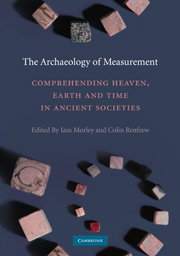Book contents
- Frontmatter
- Contents
- List of figures and tables
- List of contributors
- Acknowledgements
- The Archaeology of Measurement
- Introduction: Measure: Towards the construction of our world
- SECTION I NUMBER: COUNTING, MATHEMATICS AND MEASURE
- SECTION II MATERIALISING THE ECONOMY
- 7 Measuring by weight in the Late Bronze Age Aegean: The people behind the measuring tools
- 8 The concept of weighing during the Bronze Age in the Aegean, the Near East and Europe
- 9 Measuring the Harappan world: Insights into the Indus order and cosmology
- SECTION III DIMENSIONS AND BELIEF
- SECTION IV CALENDAR AND COSMOLOGY
- SECTION V THE SPIRITUALITY OF MEASURE
- Index
- References
9 - Measuring the Harappan world: Insights into the Indus order and cosmology
Published online by Cambridge University Press: 05 June 2012
- Frontmatter
- Contents
- List of figures and tables
- List of contributors
- Acknowledgements
- The Archaeology of Measurement
- Introduction: Measure: Towards the construction of our world
- SECTION I NUMBER: COUNTING, MATHEMATICS AND MEASURE
- SECTION II MATERIALISING THE ECONOMY
- 7 Measuring by weight in the Late Bronze Age Aegean: The people behind the measuring tools
- 8 The concept of weighing during the Bronze Age in the Aegean, the Near East and Europe
- 9 Measuring the Harappan world: Insights into the Indus order and cosmology
- SECTION III DIMENSIONS AND BELIEF
- SECTION IV CALENDAR AND COSMOLOGY
- SECTION V THE SPIRITUALITY OF MEASURE
- Index
- References
Summary
Introduction
The origins of certain types of weights and measures in South Asia can be traced back to the earliest cities of the Indus civilization. This chapter presents an overview of the types of artefacts that inform us about ancient Harappan measurement systems, in order to gain insight into their concepts of order and cosmology. The main focus is on recent discoveries at the site of Harappa, Pakistan, where detailed measurements have been made of a wide range of artefacts in an attempt to understand better the standardization and regional variation of Indus measurement systems.
The Indus civilization or Harappan culture refers to the first urban society that emerged in the greater Indus valley of Pakistan and northwestern India, between 2600 and 1900 BCE (Figure 9.1). After its discovery in the 1920s, in the course of excavations at the sites of Harappa and Mohenjo-daro (now in Pakistan), the Indus civilization was widely thought to have been one of the most highly organized urban societies in the third millennium BCE. This perception was based in part on general impressions about the layout of city streets, and the similarities of brick and weight sizes throughout the greater Indus valley. The north-south and east-west layout of the architecture and city streets, along with the relatively uniform proportions of baked bricks, was thought to reflect concepts of order, cosmology and standardization imposed by the rulers of the Indus cities.
- Type
- Chapter
- Information
- The Archaeology of MeasurementComprehending Heaven, Earth and Time in Ancient Societies, pp. 106 - 122Publisher: Cambridge University PressPrint publication year: 2010
References
- 21
- Cited by



